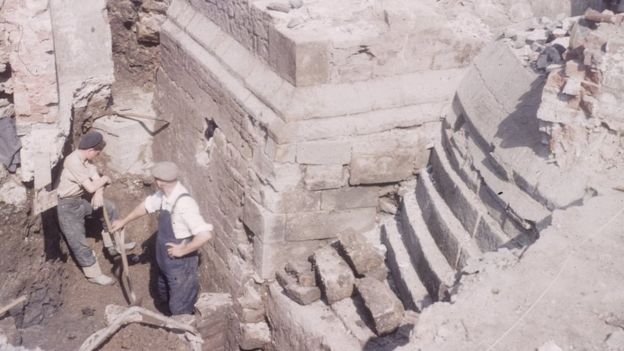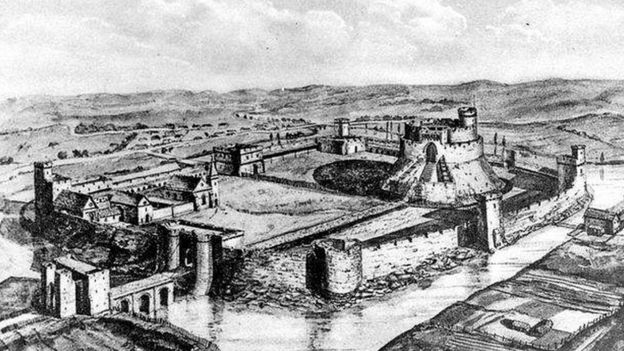Excavation work has started in a bid to find out what is left of a castle where Mary, Queen of Scots, was imprisoned.
A series of trial trenches will be dug in previously uninvestigated areas where Sheffield Castle once stood.
The dig, said to be the first comprehensive survey of the Castlegate site, is part of a £786,000 council scheme to revamp the area.
Sheffield Castlegate: Major excavation project begins
13 August 2018
BBC News

The dig will focus on where Sheffield's Castle Market previously stood
Excavation work has started in a bid to find out what is left of a castle where Mary, Queen of Scots, was imprisoned.
A series of trial trenches will be dug in previously uninvestigated areas where Sheffield Castle once stood.
The dig, said to be the first comprehensive survey of the Castlegate site, is part of a £786,000 council scheme to revamp the area.
Castlegate is the oldest part of Sheffield and has been inhabited since at least the 11th Century.
Yorkshire breaking news: Fears over 'theme park' plan for abbey; Do you own £1m-winning lottery ticket?
Mary Queen of Scots was imprisoned at Sheffield Castle and Manor Lodge for 14 years in the 1500s under the care of the Earl of Shrewsbury.

Mary, Queen of Scots, was executed in 1587
Sheffield Castle was destroyed in 1648 and its remains were covered by Castle Market in the 1960s, with the only visible parts locked in basements.
The indoor market was demolished in 2015, with the cleared space now allowing wider excavation work to take place.

Workmen found the gate house of Sheffield Castle in 1958
Wessex Archaeology said its work would take nine weeks, with its findings then shared with Sheffield City Council and other interested parties.
Mili Rajic, project manager for the dig, said: "In the 15th and 16th Century this was a very substantial and important building, this is where Sheffield started expanding.
"It was probably the largest stone-built castle in the country at the time."

Artist's impression of what Sheffield Castle looked like in the 13th Century
Prof John Moreland, from the University of Sheffield's archaeology department, said: "It has been a long haul with people pushing for excavations here for a long time, so for us it's a great day.
"Excavations in the 1920s and 1950s uncovered large parts including the gatehouse, the moat, some interior buildings and perhaps part of the dungeon, so it's clear there's significant archaeology here."
The Castlegate redevelopment will also see a new green "corridor", the transformation of empty shops and work to protect the city's Old Town Hall.
https://www.bbc.co.uk/news/uk-england-south-yorkshire-45169410
A series of trial trenches will be dug in previously uninvestigated areas where Sheffield Castle once stood.
The dig, said to be the first comprehensive survey of the Castlegate site, is part of a £786,000 council scheme to revamp the area.
Sheffield Castlegate: Major excavation project begins
13 August 2018
BBC News

The dig will focus on where Sheffield's Castle Market previously stood
Excavation work has started in a bid to find out what is left of a castle where Mary, Queen of Scots, was imprisoned.
A series of trial trenches will be dug in previously uninvestigated areas where Sheffield Castle once stood.
The dig, said to be the first comprehensive survey of the Castlegate site, is part of a £786,000 council scheme to revamp the area.
Castlegate is the oldest part of Sheffield and has been inhabited since at least the 11th Century.
Yorkshire breaking news: Fears over 'theme park' plan for abbey; Do you own £1m-winning lottery ticket?
Mary Queen of Scots was imprisoned at Sheffield Castle and Manor Lodge for 14 years in the 1500s under the care of the Earl of Shrewsbury.

Mary, Queen of Scots, was executed in 1587
Sheffield Castle was destroyed in 1648 and its remains were covered by Castle Market in the 1960s, with the only visible parts locked in basements.
The indoor market was demolished in 2015, with the cleared space now allowing wider excavation work to take place.

Workmen found the gate house of Sheffield Castle in 1958
Wessex Archaeology said its work would take nine weeks, with its findings then shared with Sheffield City Council and other interested parties.
Mili Rajic, project manager for the dig, said: "In the 15th and 16th Century this was a very substantial and important building, this is where Sheffield started expanding.
"It was probably the largest stone-built castle in the country at the time."

Artist's impression of what Sheffield Castle looked like in the 13th Century
Prof John Moreland, from the University of Sheffield's archaeology department, said: "It has been a long haul with people pushing for excavations here for a long time, so for us it's a great day.
"Excavations in the 1920s and 1950s uncovered large parts including the gatehouse, the moat, some interior buildings and perhaps part of the dungeon, so it's clear there's significant archaeology here."
The Castlegate redevelopment will also see a new green "corridor", the transformation of empty shops and work to protect the city's Old Town Hall.
https://www.bbc.co.uk/news/uk-england-south-yorkshire-45169410